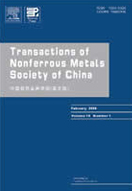Electrochemical corrosion properties of Zr- and Ti-based
bulk metallic glasses
bulk metallic glasses
(1. State Key Laboratory of Solidification Processing, Northwestern Polytechnical University,
Xi’an 710072, China;
2. Wuhan Research Institute of Materials Protection, Wuhan 430030, China)
Xi’an 710072, China;
2. Wuhan Research Institute of Materials Protection, Wuhan 430030, China)
Abstract: The corrosion behaviors of Ti-based and Zr-based amorphous alloys and their corresponding crystallized alloys were studied by electrochemical methods. It is found that the corrosion potentials of Zr-based amorphous alloy and its corresponding crystalline counterpart are both lower than those of the Ti-based amorphous alloy in the 1 mol/L H2SO4 solution. In the 3.5% NaCl solution,Zr-based crystallized alloy exhibits the lowest corrosion potential among the experimental samples. No passivation is observed in the corrosion process for the Zr-based crystalline alloy. However, Zr- and Ti-based amorphous alloys both exhibit passivation characteristics. EIS measurements indicate the amorphous alloys exhibit better corrosion resistance than the crystallized one in the NaCl solution. Surface analysis shows that both amorphous alloys in the NaCl solution are eroded by pitting corrosion. In the H2SO4 solution, all the alloys display similar behaviors and their surfaces can mostly keep intact except for some cracks on the corroded surface at local region.
Key words: bulk metallic glasses; pitting corrosion; corrosion resistance; passivation

